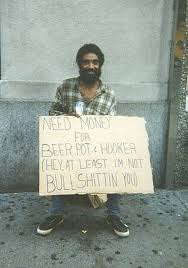Today I had another in a continuing series of phone interviews. For the uninitiated, the phone interview is a means of quick disqualification for a culled group of qualified applicants. In essence, if you receive a phone interview, a face-to-face interview is not yours to win - it's yours to lose.
The tricky bit is that a phone interview is like a like hitting a piñata; there is no possible way of telling whether you're saying the right thing or wrong thing until you receive a concrete notice of an on-site interview... or not. I have not yet had a phone interview that ended with anything less than a veiled hint that the rest of the applicants were just a formality. And yet, here I sit.
In this particular case, I was told that there were ten other applicants to screen; three, perhaps four, will be granted a face-to-face interview, after which a candidate will most likely be chosen to fill the position.
There are a number of sites online that offer suggestions for succeeding in a phone interview, but none clearly elucidate the most important aspect - that this is not an interview designed to bring you in - it is an interview to exclude you. For example, in this interview the tone of the interview was extremely upbeat and positive... until the following question came up:
"Now, as to salary... we're not sure where... we haven't set a salary for this position yet. What would you consider fair?'
Here, to me, was an exclusionary point. With ten years experience and a mid-five figure salary in the past, I may have priced myself out of consideration. In the past, dancing around the subject with the word "negotiable" would have been appropriate. In this economy, however...
I chose to inform the interviewer of my circumstance, and placed my minimum salary requirements precisely at my unemployment payment level - roughly half my former salary - with a slight increase to cover expected yearly travel expenses. "Beyond that," I continued, "anything more would be largesse."
There are those who would argue that honesty may not be the best policy. Most of those people have not experienced unemployment in this economy. The fact is, I would work for that wage at this point, and stating so honestly, explaining the circumstance - while making it clear that a more reasonable sum would be appreciated - places me absolutely in the position-to-beat. Other applicants would have to surpass my level of experience and not price themselves out of contention before taking my place on the hiring line.
At least, that's what I believe. Welcome to the land of piñata. I'll keep you informed.
Friday, August 6, 2010
Sign Me Up!
Life on the open road does not preclude the need to eat; dumpster diving is a short-term solution, but you'll find out quickly that food that is not mottled, dank and discarded is one of the great pleasures in life. For that, you're going to need cash. And you're going to have to collect it, a quarter at a time.
In preparation for living off the land, I've been researching bum signs. One of the more creative aspects of street living, it's a combination of street art and practical marketing that can pay off in a solid meal without the need for a paycheck.
Besides the need for a steady stream of foot traffic (more on that later), the success or failure of your panhandling endeavor largely depends on the strength of your advertising. Unlike the traditional job search, mooching is an entirely egalitarian endeavor, paid for by fans of your personal style and message. Here are some quick tips to succeed as a human billboard.
1) Size matters - No one wants to see a bum; your disturbing appearance in the tidy order of the working world is unnerving. People will avoid your gaze, and instead acquaint themselves with the details of the pavement beneath their feet, or suddenly feel the need to check their watches. To suceed, you need to engage at a distance, create a positive initial impression and somehow cull goodwill from an apathetic audience in a matter of seconds. That's going to require a sign that can be read from at least 12' away. You're going to need a minimum of 3'X 2' for a canvas, with the optimum size being 4'X 3'.
Your message must be concise, in a large font for ease of reading from a distance. Keep in mind that, at an average walking pace, pedestrians cover 1.5 feet per second. That's 90 feet per minute. Your message must engage and produce an intent to contribute in a fraction of that.
2) SOB stories don't sell - Your condition is inherent in your mission; I repeat, your disturbing appearance among the employed on the street is unnerving. Underscoring this point on your sign will harm your campaign, unless you are trying for the hardcore pity payment, in which case you'll need to work on your appearance to seem especially helpless and downtrodden.
Most of our new wave hobos will come from a position of economic downturn; it's a situation that pedestrians can relate to, and therefore it is best to engage your audience from the position of a helpless equal. In the thirties, the phrase was, "Brother, can you spare a dime?" Everything that is old is new again - this is your ideal panhandling positioning.
3) Adopt a position of penance - It could be argued that panhandling is your job; you must do it correctly to see profit from it. Avoid headphones, or other means of entertainment. Any sign that you are coping with your situation easily will dissuade possible contributors. Remember - panhandling is the ultimate in public relations; avoid any signal that might cloud your message. You are unemployed - you want to be employed - you are a destitute but honest citizen of a crumbling economy. Brother, can you spare a dime?
4) Self-effacing is best - Political rants are not only useless, but will dissuade otherwise willing contributors by assaulting their belief system.Similarly, anger or bitterness makes you a less appealing figure. A gentle message with self-effacing humor is your best bet to catch the attention and sympathy of the working masses.
In preparation for living off the land, I've been researching bum signs. One of the more creative aspects of street living, it's a combination of street art and practical marketing that can pay off in a solid meal without the need for a paycheck.
Besides the need for a steady stream of foot traffic (more on that later), the success or failure of your panhandling endeavor largely depends on the strength of your advertising. Unlike the traditional job search, mooching is an entirely egalitarian endeavor, paid for by fans of your personal style and message. Here are some quick tips to succeed as a human billboard.
1) Size matters - No one wants to see a bum; your disturbing appearance in the tidy order of the working world is unnerving. People will avoid your gaze, and instead acquaint themselves with the details of the pavement beneath their feet, or suddenly feel the need to check their watches. To suceed, you need to engage at a distance, create a positive initial impression and somehow cull goodwill from an apathetic audience in a matter of seconds. That's going to require a sign that can be read from at least 12' away. You're going to need a minimum of 3'X 2' for a canvas, with the optimum size being 4'X 3'.
Your message must be concise, in a large font for ease of reading from a distance. Keep in mind that, at an average walking pace, pedestrians cover 1.5 feet per second. That's 90 feet per minute. Your message must engage and produce an intent to contribute in a fraction of that.
2) SOB stories don't sell - Your condition is inherent in your mission; I repeat, your disturbing appearance among the employed on the street is unnerving. Underscoring this point on your sign will harm your campaign, unless you are trying for the hardcore pity payment, in which case you'll need to work on your appearance to seem especially helpless and downtrodden.
Most of our new wave hobos will come from a position of economic downturn; it's a situation that pedestrians can relate to, and therefore it is best to engage your audience from the position of a helpless equal. In the thirties, the phrase was, "Brother, can you spare a dime?" Everything that is old is new again - this is your ideal panhandling positioning.
3) Adopt a position of penance - It could be argued that panhandling is your job; you must do it correctly to see profit from it. Avoid headphones, or other means of entertainment. Any sign that you are coping with your situation easily will dissuade possible contributors. Remember - panhandling is the ultimate in public relations; avoid any signal that might cloud your message. You are unemployed - you want to be employed - you are a destitute but honest citizen of a crumbling economy. Brother, can you spare a dime?
4) Self-effacing is best - Political rants are not only useless, but will dissuade otherwise willing contributors by assaulting their belief system.Similarly, anger or bitterness makes you a less appealing figure. A gentle message with self-effacing humor is your best bet to catch the attention and sympathy of the working masses.
Subscribe to:
Comments (Atom)



